Abstract
Legal scholars have long assumed that plea bargains are contracts negotiated between rational actors who adhere to the dictates of the normative shadow-of-trial model. The two key features that rational actors presumably haggle over in the shadow of trial are the criminal charge (and associated sentence) and the probability of trial conviction. The behavioral economics theory of discounting, however, offers a theoretical foundation for testing the shadow-of-trial model. This article summarizes findings from experimental discounting studies in behavioral economics and psychological science – showing that these paradigms can be successfully applied to the plea-bargaining decision context wherein the likelihood of trial is uncertain and delayed, and the plea bargain is relatively certain and immediate. We suggest that the implications of applying discounting to plea bargaining are three-fold: (1) empirical evidence suggests that the shadow-of-trial model is too narrow; (2) the discounting of non-monetary losses may involve slightly different psychological processes than contexts involving monetary outcomes; and (3) probability of conviction and delay until trial constitute situational features that elicit guilty pleas despite a defendant’s factual innocence.
Acknowledgments
The authors are solely responsible for the research that was conducted and reported herein. The article draws heavily upon Lauren Clatch’s dissertation, completed August 2021. We thank Andrew Sell, Alicia Hofelich Mohr, and Abbey Hammell for providing invaluable support in constructing the survey instrument’s complex display logic.
A.1 Attention and Quality Checks

To detect VPN-use to hide participants’ lack of presence in the United States, the picture of eggplants was used to exclude participants suspected of not being in the United States. The name “aubergine” is used in the UK, Ireland, and France, and the name “brinjal” is used in South Asia. Sixty-three participants called the eggplants brinjal and thus were excluded.
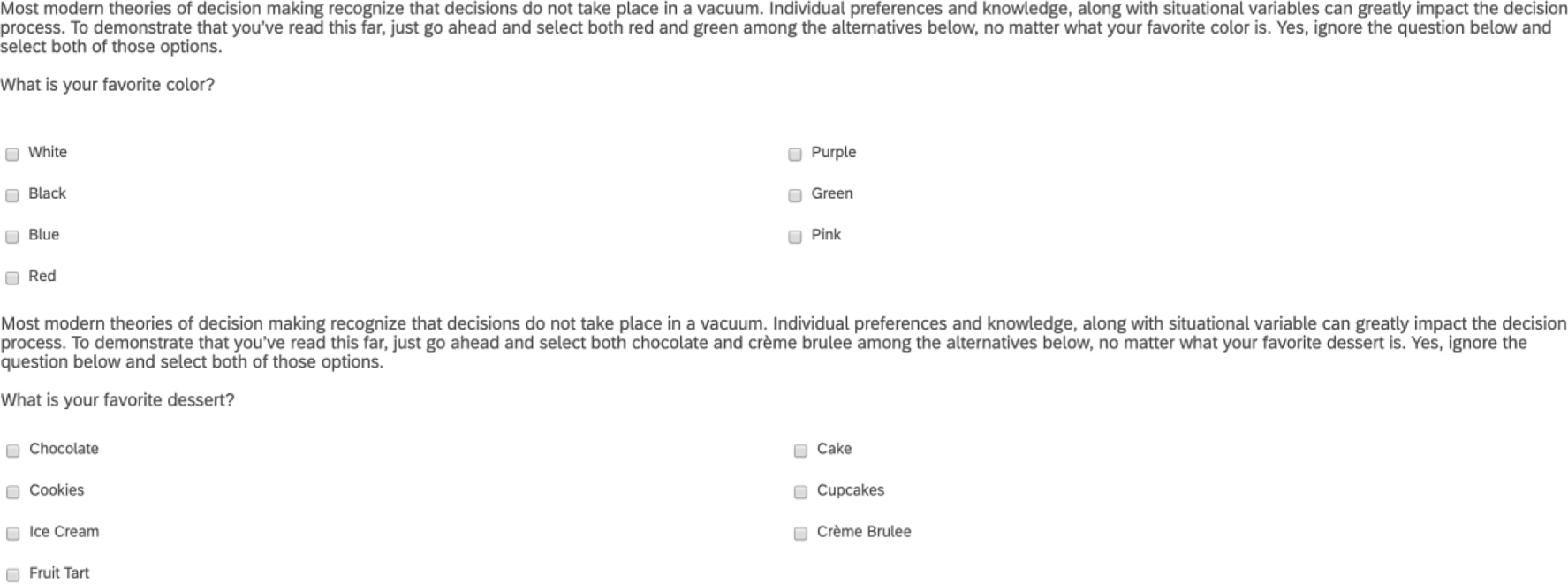
A.2 Reading Comprehension Questions
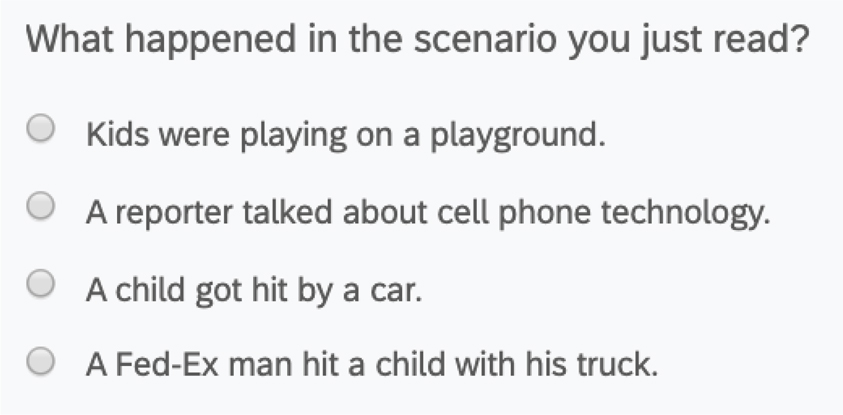
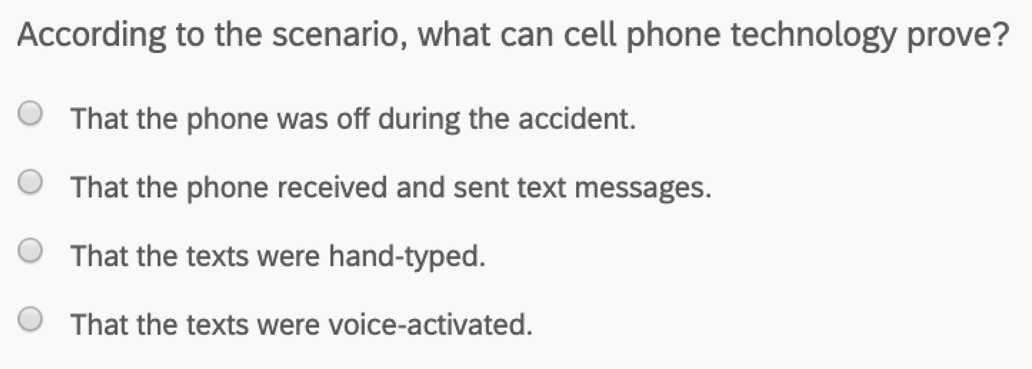
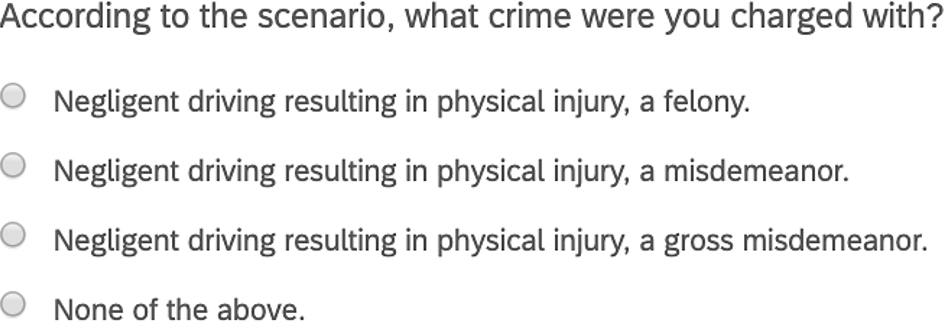
A.3 Experimental Scenario and Plea-Bargain Decisions
You were driving within the speed limit in a residential area, when you received a text from your friend. You used the voice-activation feature to read the text to you. As you were dictating your response, a child ran in front of your car, chasing a ball. You slammed on your brakes, but your vehicle struck the child, breaking his leg. The police were called and you have been charged with negligent driving resulting in physical injury, a felony.
While it is legal to send texts on your cell phone in hands-free mode, it is not legal to hand-type a text while driving. The cell phone technology can demonstrate that you received and sent text messages at the time of the accident, but it cannot establish whether the texts were hand-typed or voice-activated. However, a Fed-Ex delivery employee was in the vicinity during the accident and remembers your head was down with your gaze in your lap at the time of the incident.
A.4 Instructions
Please read the details of your options below. When you have made a decision, click on the radio button of the option you prefer. When you have clicked on the radio button your answer will be automatically recorded and new options will appear on the screen. Your new options may differ slightly so please review them carefully.
A.5 Background Information
Taking a plea offer is effective immediately, whereas the decision to go to trial results in a delay of the sentence start date because trial does not start until [DELAY] from now, and the trial process could take up to a week.

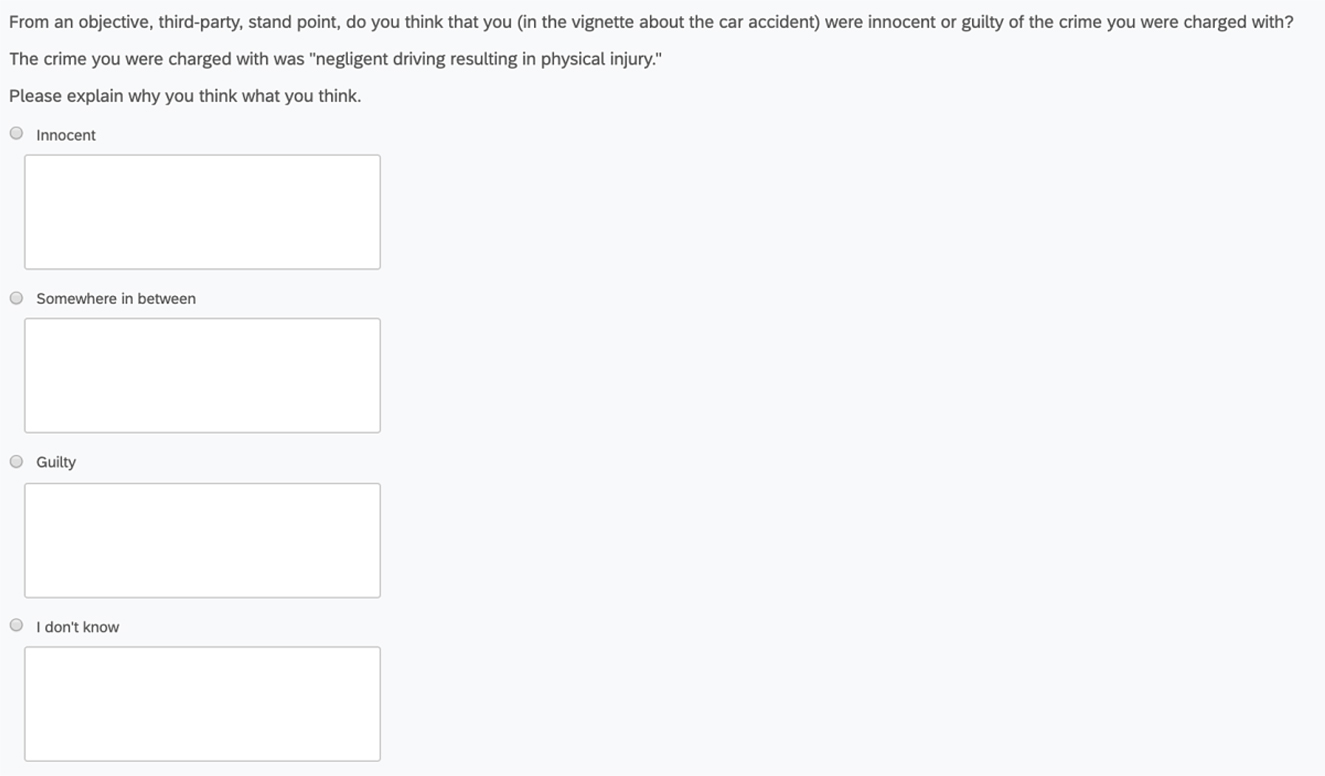
Based on the evidence, your lawyer thinks you have a [PROBABILITY]% chance you will be found guilty of the felony and be sentenced to 8 months in prison ([1-PROBABILITY]% chance of being found not guilty).
The prosecutor has decided to charge you with a felony, and is asking for a sentence of 8 months in prison if you choose to go to trial. However, the prosecutor is offering a plea deal of a gross misdemeanor, with a jail sentence of 60 days (2 months).
Which option do you choose? Click on your preferred option.
([1-PROBABILITY]% chance of freedom in trial in [DELAY]; PROBABI LITY% chance of being found guilty of a felony and sentenced to 240 days (8 months) in jail
100% certainty of a gross misdemeanor with a sentence of 60 days (2 months) in jail starting today
The text highlighted in blue is present only in Waiting-for-Trial Location’s Jail conditions. The text highlighted in yellow is present only in the Bail conditions, and nothing was present in that space in the Ambiguous conditions.
A.6 Other Materials and Measures



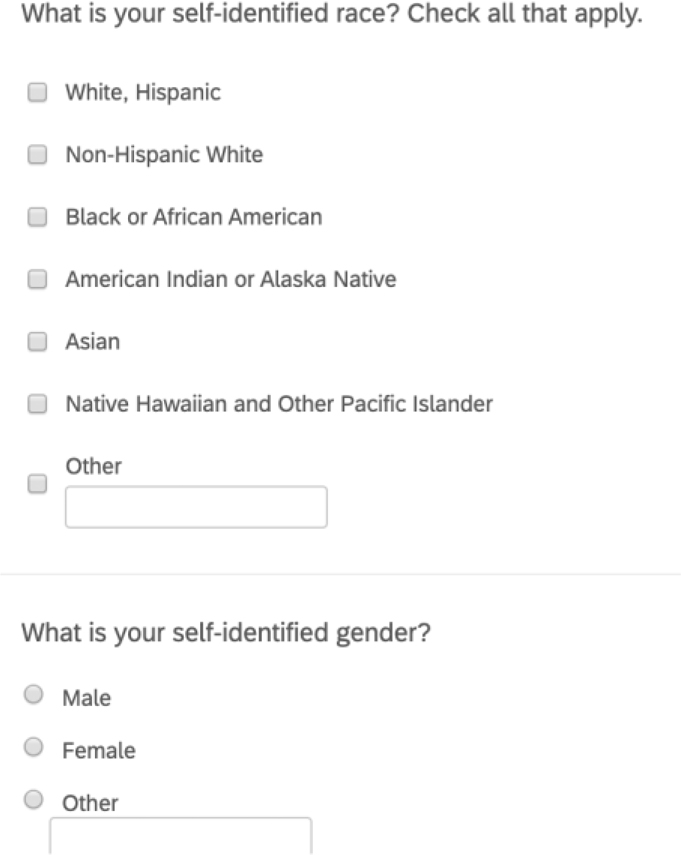

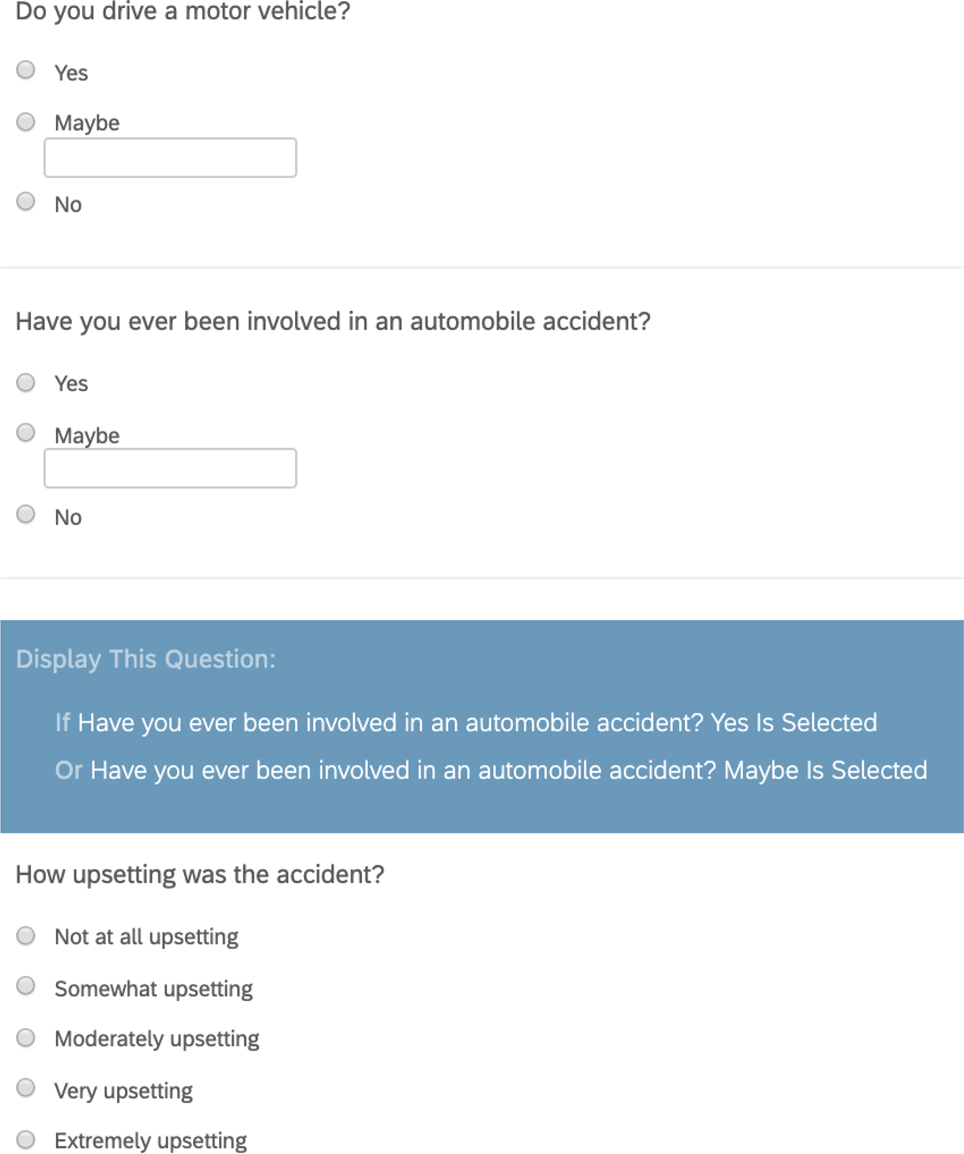


A.7 Subjective Trial Aversion Decision Tree
Each participant saw the top decision (with probability and delay specified instead of “uncertain and delayed”) and then, based on their response, they saw a second decision. If they selected the plea in the first decision, then they saw the second decision connected by the single line, running down to the left. If they selected trial in the first decision, then they saw the second decision connected by two lines, running down to the right. This continued for four decisions per delay, and then reset for the next delay, starting the participant back at the top of the decision tree, cycling through five times (once for each level of Delay until Trial).
References
Ayres, I. and Borowsky, J. (2008). A study of racially disparate outcomes in the Los Angeles Police Department. Los Angeles, CA: ACLU of Southern California.Search in Google Scholar
Bartlett, J.M. and Zottoli, T.M. (2021). The paradox of conviction probability: mock defendants want better deals as risk of conviction increases. Law Hum. Behav. 45: 39–54. https://doi.org/10.1037/lhb0000432.Search in Google Scholar
Berinsky, A.J., Margolis, M.F., and Sances, M.W. (2014). Separating the shirkers from the workers? making sure respondents pay attention on self‐administered surveys. Am. J. Polit. Sci. 58: 739–753. https://doi.org/10.1111/ajps.12081.Search in Google Scholar
Bibas, S. (2004). Plea bargaining outside the shadow of trial. Harv. Law Rev. 117: 2463–2547. https://doi.org/10.2307/4093404.Search in Google Scholar
Blackstone, W. (1826). Commentaries on the Laws of England, vol. 4. J. W. Walker, London, p. 358.Search in Google Scholar
Brown, M.P. and Bunnell, S.E. (2006). Negotiating justice: prosecutorial perspectives on federal plea bargaining in the District of Columbia. Am. Crim. Law Rev. 43: 1063–1093.Search in Google Scholar
Bushway, S. (2019). Defendant decision-making in plea bargains. In: Edkins, V. and Redlich, A. (Eds.), A system of pleas: social science’s contributions to the real legal system. Oxford University Press, New York, pp. 24–36.10.1093/oso/9780190689247.003.0003Search in Google Scholar
Bushway, S.D. and Redlich, A.D. (2012). Is plea bargaining in the ‘shadow of the trial’ a mirage? J. Quant. Criminol. 28: 437–454. https://doi.org/10.1007/s10940-011-9147-5.Search in Google Scholar
Bushway, S.D., Allison Redlich, D., and Norris, R.J. (2014). An explicit test of plea bargaining in the ‘shadow of the trial’. Criminology 52: 723–754. https://doi.org/10.1111/1745-9125.12054.Search in Google Scholar
Butler, P. (1995). Racially based jury nullification: black power in the criminal justice system. Yale Law J. 105: 677–725. https://doi.org/10.2307/797197.Search in Google Scholar
Clatch, L. (2017). Shining a light on the shadow-of-trial model: a bridge between discounting and plea bargaining. Minn. Law Rev. 102: 923–967.Search in Google Scholar
Clatch, L. and Borgida, E. (2021). Plea bargaining: a test of dual discounting preferences for non-monetary losses. Pers. Soc. Psychol. Bull. 47: 1039–1056. https://doi.org/10.1177/0146167220952228.Search in Google Scholar
Covey, R. (2007). Reconsidering the relationship between cognitive psychology and plea bargaining. Marquette Law Rev. 91: 213–248.Search in Google Scholar
Covey, R. (2009). Signaling and plea bargaining’s innocence problem. Wash. Lee Law Rev. 66: 73–130.Search in Google Scholar
Covey, R. (2014). Behavioral economics and plea bargaining. In: Zamir, E. and Teichman, D. (Eds.), The Oxford handbook of behavioral economics and the law. Oxford University Press, New York.10.1093/oxfordhb/9780199945474.013.0025Search in Google Scholar
Cox, D.J. and Dallery, J. (2016). Effects of delay and probability combinations on discounting in humans. Behav. Process. 131: 15–23. https://doi.org/10.1016/j.beproc.2016.08.002.Search in Google Scholar
Devers, L. (2011). U.S. Bureau of Justice Assistance, U.S. Department of Justice, Plea and Charge Bargaining research summary, Available at: http://www.bja.gov/Publications/PleaBargainingResearchSummary.pdf.Search in Google Scholar
Devine, D.J., Clayton, L.D., Dunford, B.B., Seying, R., and Pryce, J. (2001). Jury decision making: 45 years of empirical research on deliberating groups. Psychol. Publ. Pol. Law 7: 622–727. https://doi.org/10.1037/1076-8971.7.3.622.Search in Google Scholar
Du, W., Green, L., and Myerson, J. (2002). Cross-cultural comparisons of discounting delayed and probabilistic rewards. Psychol. Rec. 52: 479–492. https://doi.org/10.1007/bf03395199.Search in Google Scholar
Easterbrook, F.H. (1983). Criminal procedure as a market system. J. Leg. Stud. 12: 289–332. https://doi.org/10.1086/467725.Search in Google Scholar
Easterbrook, F.H. (2013). Plea bargaining is a shadow market. Duquesne Law Rev. 51: 551–558.Search in Google Scholar
Eberhardt, J.L., Davies, P.G., Purdie-Vaughns, V.J., and Johnson, S.L. (2006). Looking deathworthy: perceived stereotypicality of Black defendants predicts capital-sentencing outcomes. Psychol. Sci. 17: 383–386. https://doi.org/10.1111/j.1467-9280.2006.01716.x.Search in Google Scholar
Edkins, V.A. and Dervan, L.E. (2018). Freedom now or a future later: pitting the lasting implications of collateral consequences against pretrial detention in decisions to plead guilty. Psychol. Publ. Pol. Law 24: 204–215. https://doi.org/10.1037/law0000159.Search in Google Scholar
Frederick, S., Loewenstein, G., and O’Donoghue, T. (2003). Time discounting and time preference: a critical review. In: Loewenstein, G., Read, D., and Baumeister, R. (Eds.), Time and decision: economic and psychological perspectives on intertemporal choice. Russel Sage Foundation, New York, pp. 13–85.10.2307/j.ctvcm4j8j.11Search in Google Scholar
Garnier-Dykstra, L.M. and Wilson, T. (2019). Behavioral economics and framing effects in guilty pleas: a defendant decision making experiment. Justice Q. 38: 224–248. https://doi.org/10.1080/07418825.2019.1614208.Search in Google Scholar
Gilovich, T.D. and Griffin, D.W. (2010). Judgment and decision making. In: Handbook of social psychology, 1. John Wiley & Sons, Inc., Hoboken, p. 542.10.1002/9780470561119.socpsy001015Search in Google Scholar
Gregory, W.L., John, C.M., and Darwyn, E.L. (1978). Social psychology and plea bargaining: applications, methodology, and theory. J. Pers. Soc. Psychol. 36: 1521–1530. https://doi.org/10.1037/0022-3514.36.12.1521.Search in Google Scholar
Griffin, D.W. and Ross, L. (1991). Subjective construal, social inference, and human misunderstanding. In: Zanna, M. (Ed.), Advances in experimental social psychology, vol. 24. Academic Press, New York, pp. 319–356.10.1016/S0065-2601(08)60333-0Search in Google Scholar
Hagan, J. (1973). Extra-legal attributes and criminal sentencing: an assessment of a sociological viewpoint. Law Soc. Rev. 8: 357–383.10.2307/3053080Search in Google Scholar
Harris, C.R. (2012). Feelings of dread and intertemporal choice. J. Behav. Decis. Making 25: 13–28. https://doi.org/10.1002/bdm.709.Search in Google Scholar
Helm, R.K. (2017). Innocent until persuaded to plead guilty: using cognitive psychology to examine plea bargaining’s innocence problem, Unpublished doctoral dissertation. Cornell University, Ithaca, NY.Search in Google Scholar
Helm, R.K. and Reyna, V.F. (2017). Logical but incompetent plea decisions: a new approach to plea bargaining grounded in cognitive theory. Psychol. Publ. Pol. Law 23: 367–380. https://doi.org/10.1037/law0000125.Search in Google Scholar
Helm, R.K., Reyna, V.F., Franz, A.A., and Novick, R.Z. (2018). Too young to plead? Risk, rationality, and plea bargaining’s innocence problem in adolescents. Psychol. Publ. Pol. Law 24: 180–191. https://doi.org/10.1037/law0000156.Search in Google Scholar
Henderson, K.S. and Levett, L.M. (2018). Investigating predictors of true and false guilty pleas. Law Hum. Behav. 42: 427–441. https://doi.org/10.1037/lhb0000297.Search in Google Scholar
Hinton, E., Henderson, L., and Reed, C. (2018). An unjust burden: the disparate treatment of Black Americans in the criminal justice system. Vera Institute of Justice, New York. Available at: https://www.issuelab.org/resources/30758/30758.pdf.Search in Google Scholar
Holt, D.D., Green, L., and Myerson, J. (2012). Estimating the subjective value of future rewards: comparison of adjusting-amount and adjusting-delay procedures. Behav. Process. 90: 302–310. https://doi.org/10.1016/j.beproc.2012.03.003.Search in Google Scholar
Innocence Project. (2017). DNA exonerations in the United States, Available at: http://www.innocenceproject.org/dna-exonerations-in-the-united-states. (Last visited 3 December 2017).Search in Google Scholar
Jolls, C., Sunstein, C.R., and Thaler, R. (1998). A behavioral approach to law and economics. Stanford Law Rev. 50: 1471–1550. https://doi.org/10.2307/1229304.Search in Google Scholar
Kovera, M.B. and Levett, L.M. (2015). Jury decision making. In: APA handbook of forensic psychology, Vol. 2: Criminal investigation, adjudication, and sentencing outcomes. American Psychological Association, Washington D.C., pp. 271–311.10.1037/14462-010Search in Google Scholar
Kutateladze, B.L., Andiloro, N.R., Johnson, B.D., and Cassie, C.S. (2014). Cumulative disadvantage: examining racial and ethnic disparity in prosecution and sentencing. Criminology 52: 514–551. https://doi.org/10.1111/1745-9125.12047.Search in Google Scholar
Loewenstein, G. (1987). Anticipation and the valuation of delayed consumption. Econ. J. 97: 666–684. https://doi.org/10.2307/2232929.Search in Google Scholar
Manhattan Institute. (2017). South Carolina overcriminalization, Retrieved July 8, 2021, from: https://media4.manhattan-institute.org/sites/default/files/IB-JC-0118.pdf.Search in Google Scholar
McKerchar, T.L. and Renda, C.R. (2012). Delay and probability discounting in humans: an overview. Psychol. Rec. 62: 817–834. https://doi.org/10.1007/bf03395837.Search in Google Scholar
Metcalfe, C. and Chiricos, T. (2018). Race, plea, and charge reduction: an assessment of racial disparities in the plea process. Justice Quarterly 35: 223–253. https://doi.org/10.1080/07418825.2017.1304564.Search in Google Scholar
Mitchell, J.N. (1969). Bail reform and the constitutionality of pretrial detention. Va. Law Rev. 55: 1223–1242. https://doi.org/10.2307/1071765.Search in Google Scholar
Penrod, S. and Hastie, R. (1979). Models of jury decision making: a critical review. Psychol. Bull. 86: 462–492. https://doi.org/10.1037/0033-2909.86.3.462.Search in Google Scholar
Petersen, K., Redlich, A.D., and Norris, R.J. (2020). Diverging from the shadows: explaining individual deviation from plea bargaining in the ‘shadow of the trial. J. Exp. Criminol. 1–22. https://doi.org/10.1007/s11292-020-09449-4.10.1007/s11292-020-09449-4Search in Google Scholar
Piehl, A.M. and Bushway, S.D. (2007). Measuring and explaining charge bargaining. J. Quant. Criminol. 23: 105–125. https://doi.org/10.1007/s10940-006-9023-x.Search in Google Scholar
Quickel, E.J. and Zimmerman, D.M. (2019). Race, culpability, and defendant plea-bargaining decisions: an experimental simulation. J. Forensic Psychol. Pract. 19: 93–111. https://doi.org/10.1080/08839514.2018.1517294.Search in Google Scholar
Rachlin, H., Raineri, A., and Cross, D. (1991). Subjective probability and delay. J. Exp. Anal. Behav. 55: 233–244. https://doi.org/10.1901/jeab.1991.55-233.Search in Google Scholar
Redlich, A.D. and Shteynberg, R.V. (2016). To plead or not to plead: a comparison of juvenile and adult true and false plea decisions. Law Hum. Behav. 40: 611–625. https://doi.org/10.1037/lhb0000205.Search in Google Scholar
Reitz, K. (2018). American exceptionalism in crime and punishment. Oxford University Press, New York, NY.10.1093/oso/9780190203542.001.0001Search in Google Scholar
Roberts, S.O. and Rizzo, M.T. (2021). The psychology of American racism. Am. Psychol. 76: 475–487. https://doi.org/10.1037/amp0000642.Search in Google Scholar
Roberts, S.O., Bareket-Shavit, C., Dollins, F.A., Goldie, P.D., and Mortenson, E. (2020). Racial inequality in psychological research: trends of the past and recommendations for the future. Perspect. Psychol. Sci. 15: 1295–1309. https://doi.org/10.1177/1745691620927709.Search in Google Scholar
Ross, L. and Nisbett, R.E. (1991). The person and the situation: perspectives of social psychology. McGraw-Hill, New York.Search in Google Scholar
Scott, R.E. and Stuntz, W.J. (1991). Plea bargaining as contract. Yale Law J. 101: 1909.10.2307/796952Search in Google Scholar
Simon, H.A. (1955). A behavioral model of rational choice. Q. J. Econ. 69: 99–118. https://doi.org/10.2307/1884852.Search in Google Scholar
Simon, H.A. (1990). Invariants of human behavior. Annu. Rev. Psychol. 41: 1–20. https://doi.org/10.1146/annurev.ps.41.020190.000245.Search in Google Scholar
Spohn, C. (2011). Race, ethnicity, and crime. In: Tonry, M. (Ed.), The Oxford handbook of crime and criminal justice. Oxford University Press, New York.10.1093/oxfordhb/9780195395082.013.0011Search in Google Scholar
Stevenson, M.T. (2018). Distortion of justice: how the inability to pay bail affects case outcomes. J. Law Econ. Organ. 34: 511–542. https://doi.org/10.1093/jleo/ewy019.Search in Google Scholar
Taylor, J.R. (2011). Restoring the bargain: examining post-plea sentence enhancement as an unconscionable violation of contract law. Calif. West Law Rev. 48: 129–173.Search in Google Scholar
Thomas, W.H. (2020). Bail Reform in America. University of California Press: Berkeley.Search in Google Scholar
Tonry, M.H. (1998). The handbook of crime and punishment. Oxford University Press, New York, NY.10.1093/oso/9780195110661.001.0001Search in Google Scholar
Tor, A., Gazal-Ayal, O., and Garcia, S.M. (2010). Fairness and the willingness to accept plea bargain offers. J. Empir. Leg. Stud. 7: 97–116. https://doi.org/10.1111/j.1740-1461.2009.01171.x.Search in Google Scholar
Vanderveldt, A., Green, L., and Myerson, J. (2015). Discounting of monetary rewards that are both delayed and probabilistic: delay and probability combine multiplicatively, not additively. J. Exp. Psychol. Learn. Mem. Cognit. 41: 148–162. https://doi.org/10.1037/xlm0000029.Search in Google Scholar
Weatherly, J.N. and Kehn, A. (2013). Probability discounting of legal and non-legal scenarios: discounting varies as a function of the outcome, the recipient’s race, and the discounter’s sex. Behav. Soc. Issues 22: 74–86. https://doi.org/10.5210/bsi.v22i0.4717.Search in Google Scholar
Weatherly, J.N., Wise, R.A., and Derenne, A. (2012). Probability discounting of legal and non-legal outcomes. Behav. Soc. Issues 21: 165–187. https://doi.org/10.5210/bsi.v2110.4183.Search in Google Scholar
Wilford, M.M., Shestak, A., and Wells, G.L. (2019). Plea bargaining. In: Psychological Science and the Law. Guilford Publications, New York, pp. 266–292.Search in Google Scholar
Wilkinson, N. and Klaes, M. (2017). An introduction to behavioral economics. Macmillan International Higher Education, London.Search in Google Scholar
Zimmerman, D.M. and Hunter, S. (2018). Factors affecting false guilty pleas in a mock plea bargaining scenario. Leg. Criminol. Psychol. 23: 53–67. https://doi.org/10.1111/lcrp.12117.Search in Google Scholar
© 2021 Walter de Gruyter GmbH, Berlin/Boston
Articles in the same Issue
- Frontmatter
- Article
- The Impact of Behavioral Economics on the Law: Introduction
- Special Issue Articles
- The Paternalistic Turn in Behavioral Law and Economics: A Critique
- Behavioral Contract Law
- The Limits of Behavioral Economics in Tort Law
- Behavioral Economics in Plea-Bargain Decision-Making: Beyond the Shadow-of-Trial Model
- Behavioral Economics and Court Decision-Making
- The Role of Bias in Economic Models of Law
- Behavioral Biases and the Law
- The Evolutionary Force of Behavioral Economics in Law
Articles in the same Issue
- Frontmatter
- Article
- The Impact of Behavioral Economics on the Law: Introduction
- Special Issue Articles
- The Paternalistic Turn in Behavioral Law and Economics: A Critique
- Behavioral Contract Law
- The Limits of Behavioral Economics in Tort Law
- Behavioral Economics in Plea-Bargain Decision-Making: Beyond the Shadow-of-Trial Model
- Behavioral Economics and Court Decision-Making
- The Role of Bias in Economic Models of Law
- Behavioral Biases and the Law
- The Evolutionary Force of Behavioral Economics in Law

